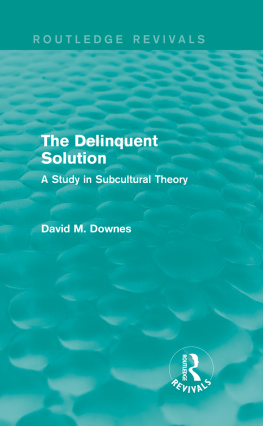SEPARATION REVISITED
First published 1992 by Ashgate Publishing
Reissued 2018 by Routledge
2 Park Square, Milton Park, Abingdon, Oxon, OX14 4RN
52 Vanderbilt Avenue, New York, NY 10017
Routledge is an imprint of the Taylor & Francis Group, an informa business
Copyright Celia Downes 1992
All rights reserved. No part of this book may be reprinted or reproduced or utilised in any form or by any electronic, mechanical, or other means, now known or hereafter invented, including photocopying and recording, or in any information storage or retrieval system, without permission in writing from the publishers.
Notice:
Product or corporate names may be trademarks or registered trademarks, and are used only for identification and explanation without intent to infringe.
Publishers Note
The publisher has gone to great lengths to ensure the quality of this reprint but points out that some imperfections in the original copies may be apparent.
Disclaimer
The publisher has made every effort to trace copyright holders and welcomes correspondence from those they have been unable to contact.
A Library of Congress record exists under LC control number: 92016262
Laserset by Computype Manuscript Services
ISBN 13: 978-1-138-34049-7 (hbk)
ISBN 13: 978-0-429-44063-2 (ebk)
I would like to express my warmest thanks to the adolescents, foster parents, project social workers and senior management of the social services department where the study took place; I have chosen not to identify them in order to give additional anonymity to the adolescents and their foster parents. The inevitable loss is that I am unable to name many people who gave generously of their time and from whom I learned a great deal. The social services department supported a long term research project when they were under heavy work pressures and financial constraints, this included meeting the expenses incurred in the course of the research. A travel grant from the Hilden Charitable Foundation enabled me to arrange a study tour in North America which provided a stimulus from confronting similar issues in a different culture.
A major debt is to Dr John Bowlby who acted as a consultant to the study and constructively criticised some of the chapters. He had agreed to write a forward to the book but died before it was completed. The book is a tribute to him and particularly to his concern for young people in care and his appreciation of and respect for the complex task facing social workers, foster parents and other caregivers.
Thanks are also due to Professor Dorothy Whitaker for her invaluable advice, criticism and encouragement throughout the research; to Dr Dorothy Heard, Dr Brian Lake, Mrs Lyn Clarkson and Beth Williams for their constructive criticism of my drafts; to my colleagues who took on extra work in order to allow me time to finish the book and particularly to Professor Ian Sinclair for his unfailing support, encouragement and valuable, if astringent criticism.
For permission to quote from published material, thanks are due to the following publishers and authors: The Hogarth Press and the Institute of Psycho-Analysis, in respect of Attachment and Loss: Vol. 2, Separation: Anxiety and Anger, by J. Bowlby; The Society for Research in Child Development, Inc. at the University of Chicago Press, in respect of Security in Infancy, Childhood and Adulthood: a Move to the Level of Representation by M. Main, N. Kaplan and J. Cassidy, in Growing Points of Attachment Theory and Research, edited by I. Bretherton and E. Waters; the University of Nebraska Press, in respect of Open Communication and Internal Working Models: Their Role in the Development of Attachment Relationships by I. Bretherton, in Socioemotional Development. (Nebraska Symposium on Motivation, 1988) edited by R. Thompson; the Journal of Family Therapy for permission to quote from Family Systems and the Attachment Dynamic by D.H.Heard.
Part 1
PERSPECTIVES ON FOSTER CARE FOR ADOLESCENTS
This is a book about the relationships that develop between adolescents who are looked after by the local authority and their foster parents. It explores what it is like for them living under the same roof and sharing their lives together, having met for the first time when the adolescents are between 14 and 17 years old. By starting from foster parents and adolescents own accounts of what actually happened during time limited placements, the aim is to provide a way of understanding how they interact and what determines the course of the placement.
The book also offers ways of understanding and applying attachment theory to work with adolescents, both those in specialist fostering projects and those experiencing other forms of care. This is a new departure. In the field of family placement, attachment theory has indeed been used to explain the impact of insecure attachment, separation and loss on young children. It has provided a guide to decision making and action when helping children move into new families, (Fahlberg, 1981a, 1981b, 1982; Jewitt, 1984) and in managing behavioural problems once they are placed. (Fahlberg, 1988). It has also been used to understand the developing relationships between 5 to 9 year old boys and their substitute parents during the first year of permanent placements (Rushton, Treseder and Quinton, 1988). Nevertheless it has been criticized as offering an inappropriate or misleading perspective when applied to adolescent fostering (Hipgrave, 1989).
In this book, in contrast, attachment theory is applied to the fostering of adolescents. It provides a perspective for making sense of the powerful dynamics which frequently determine the outcome of a placement and suggests ways in which foster families, social workers and other practitioners may help or hinder adolescents efforts to make constructive use of their placements.
The book is written for social worker practitioners and practitioners of other disciplines working with adolescents who are in care as the subject of a court order or are being provided with accommodation by the local authority, it is also for specialist foster parents and for practitioners working with foster families or with adolescents own families. Much of it has wider application, for instance, to work with adolescents in small residential units and in their birth or reconstituted families.
This is not a comprehensive guide to all aspects of adolescent fostering, these are provided elsewhere, for example by Thobum, (1988), and Aldgate, Maluccio and Reeves, (1989). It is not the intention to work through all the main issues which preoccupy adolescents; for example, negotiations concerning their developing sexual relationships and friendships are not explored. Nor does this book examine the crucial issues of race and gender and the adolescents developing racial, cultural and religious identity. It is critical that these issues are considered in conjunction with the framework presented here, but this is too important a matter for a book of the size and form envisaged.
The aim is to offer a framework for understanding the relationships which develop between adolescents and foster parents and in particular the negotiations between them as adolescents move to and fro across the foster family boundary and sometimes move between their foster family and birth family. These negotiations raise issues of separation and attachment which are of importance to many adolescents but particularly for those who have had the past experiences of separation characteristic of foster children. Particular issues and events, such as finding work, and looking for a home base against the time when the placement ends are selected to explore and illustrate these negotiations; from these certain principles emerge, which, it is argued, are of considerable importance for all who work in this field. These principles have implications for understanding and assessing adolescents and foster parents, and for identifying ways in which adolescents, their birth families, foster parents, social workers and other professionals within statutory or voluntary agencies are most likely to work together effectively.














